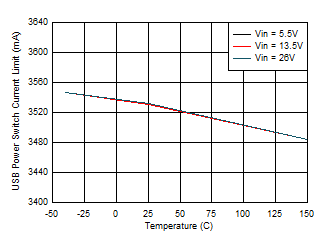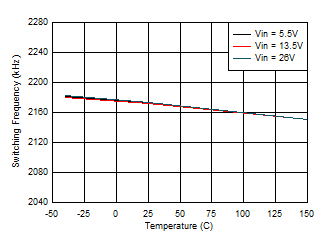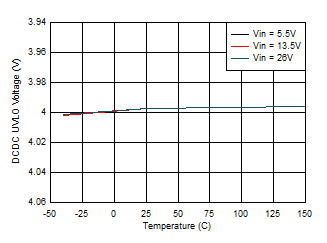JAJSMQ9 August 2021 TPS25868-Q1 , TPS25869-Q1
PRODUCTION DATA
- 1 特長
- 2 アプリケーション
- 3 概要
- 4 Revision History
- 5 概要 (続き)
- 6 Device Comparison Table
- 7 Pin Configuration and Functions
- 8 Specifications
- 9 Parameter Measurement Information
-
10Detailed Description
- 10.1 Overview
- 10.2 Functional Block Diagram
- 10.3
Feature Description
- 10.3.1 Power-Down or Undervoltage Lockout
- 10.3.2 Input Overvoltage Protection (OVP) - Continuously Monitored
- 10.3.3 Buck Converter
- 10.3.4 FREQ/SYNC
- 10.3.5 Bootstrap Voltage (BOOT)
- 10.3.6 Minimum ON-Time, Minimum OFF-Time
- 10.3.7 Internal Compensation
- 10.3.8 Selectable Output Voltage (VSET)
- 10.3.9 Current Limit and Short Circuit Protection
- 10.3.10 Cable Compensation
- 10.3.11 Thermal Management with Temperature Sensing (TS) and OTSD
- 10.3.12 Thermal Shutdown
- 10.3.13 USB Enable On/Off Control (TPS25869-Q1)
- 10.3.14 FAULT Indication
- 10.3.15 USB Specification Overview
- 10.3.16 USB Type-C® Basics
- 10.3.17 USB Port Operating Modes
- 10.4 Device Functional Modes
-
11Application and Implementation
- 11.1 Application Information
- 11.2
Typical Applications
- 11.2.1 Design Requirements
- 11.2.2
Detailed Design Procedure
- 11.2.2.1 Output Voltage Setting
- 11.2.2.2 Switching Frequency
- 11.2.2.3 Inductor Selection
- 11.2.2.4 Output Capacitor Selection
- 11.2.2.5 Input Capacitor Selection
- 11.2.2.6 Bootstrap Capacitor Selection
- 11.2.2.7 Undervoltage Lockout Set-Point
- 11.2.2.8 Cable Compensation Set-Point
- 11.2.2.9 FAULT Resistor Selection
- 11.2.3 Application Curves
- 12Power Supply Recommendations
- 13Layout
- 14Device and Documentation Support
- 15Mechanical, Packaging, and Orderable Information
8.8 Typical Characteristics
Unless otherwise specified the following conditions apply: VIN = 13.5 V, fSW = 400 kHz, L = 3.3 µH, CSENSE = 141 µF, CPA_BUS = 1 µF, CPB_BUS = 1 µF, TA = 25 °C.

| VEN/EULVO = 0 V | PA_CC1 = Rd | ||
 Figure 8-3 Precision Device Enable Threshold
Figure 8-3 Precision Device Enable Threshold
| RVSET = 80.6 kΩ |
 Figure 8-7 High-side Current Limit vs Input Voltage
Figure 8-7 High-side Current Limit vs Input Voltage
| IPA_BUS = 3 A | IPB_BUS = 2.4 A |

| ILIM = GND |

| RILIM = 15.4 kΩ |
 Figure 8-15 VCONN Power Switch Current Limit vs Junction
Temperature
Figure 8-15 VCONN Power Switch Current Limit vs Junction
Temperature Figure 8-17 USB
Power Switch On Resistance vs Junction Temperature
Figure 8-17 USB
Power Switch On Resistance vs Junction Temperature Figure 8-19 VCONN Power Switch On Resistance vs Junction
Temperature
Figure 8-19 VCONN Power Switch On Resistance vs Junction
Temperature
| RFREQ = 8.45 kΩ |
 Figure 8-23 TS
Temperature Wam Threshold vs Junction Temperature
Figure 8-23 TS
Temperature Wam Threshold vs Junction Temperature Figure 8-25 SENSE
Voltage in Temperature Hot vs Junction Temperature
Figure 8-25 SENSE
Voltage in Temperature Hot vs Junction Temperature
| VEN/UVLO = VSENSE | PA_CC1/2 = OPEN |

| VSET = GND |

| VEN/EULVO = VSENSE | PA_CC1= Rd | ||
 Figure 8-8 Low-side Current Limit vs Input Voltage
Figure 8-8 Low-side Current Limit vs Input Voltage
| IPA_BUS = 3 A | IPB_BUS = 2.4 A |

| RILIM = 9.53 kΩ |
 Figure 8-14 OUT
Power Switch Current Limit vs Junction Temperature
Figure 8-14 OUT
Power Switch Current Limit vs Junction Temperature
| IPA/B_BUS = 2.4 A | VSET = GND |
 Figure 8-18 OUT
Power Switch On Resistance vs Junction Temperature
Figure 8-18 OUT
Power Switch On Resistance vs Junction Temperature
| RFREQ = 49.9 kΩ |
 Figure 8-22 CC
Sourcing Current vs Junction Temperature
Figure 8-22 CC
Sourcing Current vs Junction Temperature Figure 8-24 TS
Temperature Hot Threshold vs Junction Temperature
Figure 8-24 TS
Temperature Hot Threshold vs Junction Temperature